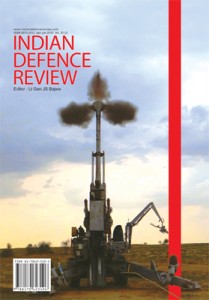The Defence Production Policy promulgated in 2011, aims at achieving substantive self-reliance in the design, development and production of equipment, weapon systems, platforms required for defence in as early a time frame as possible; creating conditions conducive for the private industry to take an active role in this endeavour; enhancing potential of SMEs in indigenisation and broadening the defence R&D base of the country.
In pursuance of the Policy of achieving substantial self-reliance in Defence Production, the Government has taken several initiatives to promote participation of domestic defence industries in Defence Production and Procurement. These include, preference to ‘Buy (Indian)’ and ‘Buy & Make (Indian)’ categories of acquisition over ‘Buy (Global)’, liberalization of FDI and Industrial Licensing Policy. Level Playing Field in respect of Customs/ Excise Duties between private sector and the public sector, etc. Details of the steps taken to boost defence manufacturing sector are given below:
- The Defence Products List for the purpose of issuing Industrial Licences (ILs) under IDR Act has been revised and most of the components, parts, sub-systems, testing equipment, production equipment have been removed from the List, so as to reduce the entry barriers for the industry, particularly small & medium segment.
- Process of applying for Industrial License (IL) and Industrial Entrepreneur Memorandum (IEM) has been made completely online and this service is now available to entrepreneurs on 24X7 basis at eBiz website without human interface.
- Guidelines have been issued to streamline the processing of applications for grant of extension of validity of Industrial License.
- The initial validity of the Industrial Licence granted under the IDR Act has been increased from 3 years to 7 years with a provision to further extend it by 3 years on a case-to-case basis.
- Partial commencement of production is treated as commencement of production of all the items included in the license.
- The ‘Security Manual for Licensed Defence Industry’ has been issued. With the issue of the Security Manual, the requirement of affidavit from the applicants, has been done away with.
- Restriction of annual capacity in the Industrial License for Defence Sector has been removed.
- Licensee has been allowed to sell the defence items to the Government entities under the control of MHA, PSUs, State Governments and Other Defence Licensee companies without approval of Department of Defence production.
- Application Forms for Industrial License & Industrial Entrepreneur Memorandum have been simplified.
- The advanced version of NIC Code (NIC 2008) has been adopted, which is a highly contemporary industrial classification.
- To establish a level-playing field between Indian private sector and the public sector, the anomalies in excise duty/ custom duty have been removed. As per the revised policy, all Indian industries (public and private) are subjected to the same kind of excise and custom duty levies.
- To promote the participation of private sector, particularly SMEs for defence manufacturing, Outsourcing and Vendor Development Guidelines for DPSUs and OFB have been formulated and circulated to them. The guidelines mandate that each DPSU and OFB to have a short-term and long-term outsourcing and vendor development plan to gradually increase the outsourcing from private sector including SMEs. The guidelines also include vendor development for import substitution.
- The Standard Operating Procedure (SOP) for the issue of No Objection Certificate (NOC) for export of military stores has been revised and put on the website. Under the revised SOP, the requirement of End User Certificate (EUC) to be countersigned/ stamped by the Government authorities has been done away with for the export of parts, components, sub-systems etc.
- The list of military stores has been finalised and has been put in the public domain to make the process transparent and unambiguous. The process of receiving applications for NOC for export of military stores and for issuing NOC has been made online to reduce the delay and to remove human interface in the process.
- The FDI policy for the defence sector has been reviewed and as per the revised policy, the composite foreign investment upto 49% is allowed through Government route (FIPB) and beyond 49% with the approval of the Cabinet Committee on Security (CCS) on case-to-case basis wherever it is likely to result in access to modern and state-of-the art technology in the country. Besides, the restrictions such as single largest Indian shareholder to hold at least 51% equity and complete restriction on Foreign Institutional Investor (FII) existing in the earlier policy have also been removed to facilitate investment in the sector.
- Recognising the need for promotion of defence exports to make the Indian defence industry economically sustainable, Defence Exports Strategy outlining the various steps to be taken, has been formulated and is put up in public domain.
- Preference to ‘Buy (Indian)’, ‘Buy & Make (Indian)’ & ‘Make’ categories of acquisition over ‘Buy (Global)’ category, thereby giving preference to Indian industry in procurement.
In addition, the Indian Navy has undertaken the following initiatives:-
This information was given by Minister of State for Defence Rao Inderjit Singh in a written reply to Dr. Kanwar Deep Singh in Rajya Sabha today.
- Formulation of Indian Naval Indigenisation Plan (2015-2030)
- Formulation of Science and Technology Roadmap.
The indigenisation initiatives in critical sectors of submarine / aircraft / helicopter building, would go a long way in achieving self-reliance and enhance the strategic autonomy of the country.
Presently, all ships and submarines on order by Indian Navy are being constructed in the Indian Shipyards. In addition, indigenous aircraft, viz, Light Combat Aircraft (Navy) is also under development at Hindustan Aeronautics Limited, Bangalore. These measures are likely to boost the industrial and economic activity in the overall defence sector and contribute towards defence preparedness and protection of national interests.





